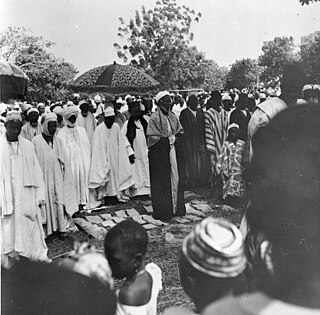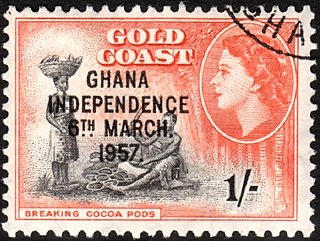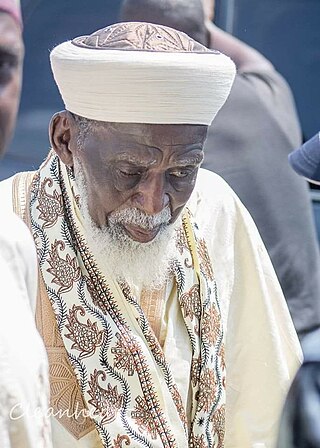
Kumasi is a city in the Ashanti Region, and is among the largest metropolitan areas in Ghana. Kumasi is located in a rain forest region near Lake Bosomtwe, and is the commercial, industrial, and cultural capital of the historical Ashanti Empire. Kumasi is approximately 500 kilometres (300 mi) north of the Equator and 200 kilometres (100 mi) north of the Gulf of Guinea. Kumasi is alternatively known as "The Garden City" because of its many species of flowers and plants in the past. It is also called Oseikrom, after Osei Kofi Tutu I who was a king in the Ashanti empire.

Tamale is the capital city of the Northern Region of Ghana. It is Ghana's third largest city, with a population of 950,000. The city has been ranked as the fastest-growing city in West Africa. It is located 600 km (370 mi) north of Accra.

Islam was the first Abrahamic monotheistic religion to arrive in Ghana. Today, it is the second most widely professed religion in the country behind Christianity. Its presence in Ghana dates back to the 10th century. According to the Ghana Statistical Service's Population and Housing census (2021), the percentage of Muslims in Ghana is about 20%.

Istiqlal Mosque in Jakarta, Indonesia is the largest mosque in Southeast Asia and the ninth largest mosque in the world in terms of worshipper capacity. Built to commemorate Indonesian independence, this national mosque of Indonesia was named "Istiqlal", an Arabic word for "independence". The mosque was opened to the public on 22 February 1978. Within Jakarta, the mosque is positioned next to Merdeka Square and the Jakarta Cathedral (Catholic) and also of the Immanuel Church (Reformed).

Mahamudu Bawumia is a Ghanaian economist and former central banker who serves as the 5th Vice President of Ghana in the 4th Ghanaian Republic. He assumed office on 7th January 2017 as Vice President of Ghana.

Ghana gained independence from the British on 6 March 1957. It is a member of the Commonwealth of Nations. The country became a republic on July 1, 1960.

Bonwire is a town in Ghana, located in the Ejisu-Juaben Municipal district within the Ashanti Region. The town is located about 18 km on the Kumasi-Mampong road. According to Akan oral tradition, Kente originates from Bonwire.

Osmanu Nuhu Sharubutu is a Ghanaian Islamic cleric who currently serves as the Chief Imam of Ghana, as well as a member of the National Peace Council. He was first appointed as the Deputy Regional Chief Imam in 1974 after a lengthy discussions among tribal chiefs, academics, Islamic scholars, and religious personalities. During this period he deputized his cousin, Imam Muhammed Mukhtar Abbas, who succeeded his father. He is also the founder of the Dr. Sheikh Osmanu Nuhu Sharubutu Education Trust Fund and the Islamic Peace and Security Council of Ghana (IPASEC).
Alhaji Mumuni Bawumia was a Ghanaian politician, lawyer and the paramount chief of Kperiga in the then Northern region of Ghana. He was chairman of the council of state in the 4th republic from 1993 to 2000.

The Ahmadiyya Muslim Community is the second largest group of Islam in Ghana after Sunni Islam. The early rise of the Community in Ghana can be traced through a sequence of events beginning roughly at the same time as the birth of the Ahmadiyya movement in 1889 in British India. It was during the early period of the Second Caliphate that the first missionary, Abdul Rahim Nayyar was sent to what was then the Gold Coast in 1921 upon invitation from Sunni Muslims in Saltpond. Having established the movement in the country, Nayyar left and was replaced by the first permanent missionary, Al Hajj Fadl-ul-Rahman Hakim in 1922.

Freda Akosua Oheneafrewo Prempeh is a Ghanaian politician, and Member of Parliament in the Seventh Parliament and Eighth Parliament of the fourth republic of Ghana representing Tano North Constituency in the Ahafo Region, Ghana. She was the Minister of State, for the Ministry of works and housing, Ghana and previously served as the Deputy Gender Minister and also Assembly member – "Assembly Woman" from 2002 to 2010 for the Lakoo Electoral Area of the La-Dadekotopo Constituency in the Greater Accra Region.
Paul Kwabena Boafo is a Ghanaian theologian and minister who was elected as the twelfth Presiding Bishop of the Methodist Church Ghana in 2018. He previously served as the Administrative Bishop of the Church. He is the first ordained minister to serve in both capacities in the episcopal history of the Ghanaian Methodist Church. Boafo also served as the Protestant Chaplain of the Kwame Nkrumah University of Science and Technology (KNUST).
Ghana Infectious Disease Centre (GIDC) is a centre built to improve the medical diagnostic and research capacity of Ghana with regard to infectious diseases. The facility was built due to the emergence of the COVID-19 pandemic in Ghana. Establishing the centre was facilitated by the Ghana COVID-19 Private Sector Fund in collaboration with the Ghana Armed Forces at the Ga East Municipal Hospital in Accra. The old Shai Osudoku District Hospital was also renovated into one of the infectious diseases centres in the Shai Osudoku District in Dodowa. This shares a boundary with the Shai Osudoku District Health Directorate. The president, Nana Addo Dankwa Akuffo Addo, inspected the centre on 30 October 2020
Peter Twumasi is a Ghanaian biochemist, author, and professor at the Kwame Nkrumah University of Science and Technology. He was the director general of the National Sports Authority of Ghana. until February 2024 when he left the position.
The Ghana National Mosque is a mosque in Ghana. It is the second largest mosque in West Africa.

Second Lady of Ghana is the title given to the wife of the vice-president of the Republic of Ghana. The current second lady is Samira Bawumia, who has held that position since 2017 when her husband Mahamudu Bawumia was sworn into office. They are not officially given salaries but the Ghanaian first and second lady are both given clothing allowances to serve as initiatives to be comfortable enough to advocate the country through material forms of culture. They usually undertake social programmes and philanthropic activities especially in relation to kids and women.

COVID-19 vaccination in Ghana began on Monday 1 March 2021 after the country became the first recipient of the Oxford-AstraZeneca COVID-19 vaccine as part of the COVAX initiative. As of 6 June 2021, Ghana has administered 1,230,000 vaccine doses.
Tamale Senior High School formerly Government Secondary School, Tamale, Gbewaa Secondary School, and more recently Tamale Secondary School is a co-educational second cycle boarding school located at Education Ridge, a suburb of the Sagnarigu Municipality. The school was founded in 1951 by the then British Colonial Authorities as the first second cycle institution of the Northern Territories.
The Abossey Okai Central Mosque also Accra Central Mosque, is a Mosque in the Abossey Okai community of Accra, Ghana. Constructed in the 1970s, the mosque was established to cater to the Muslim community in Abossey Okai and neighboring areas such as Sabon Zango.
Auntie Muni was a Ghanaian food vendor renowned for her waakye, a popular dish consisting of rice and beans. She operated her stall in Accra, Ghana, for over 35 years, becoming a beloved figure and garnering national recognition for her culinary expertise and warm personality.













